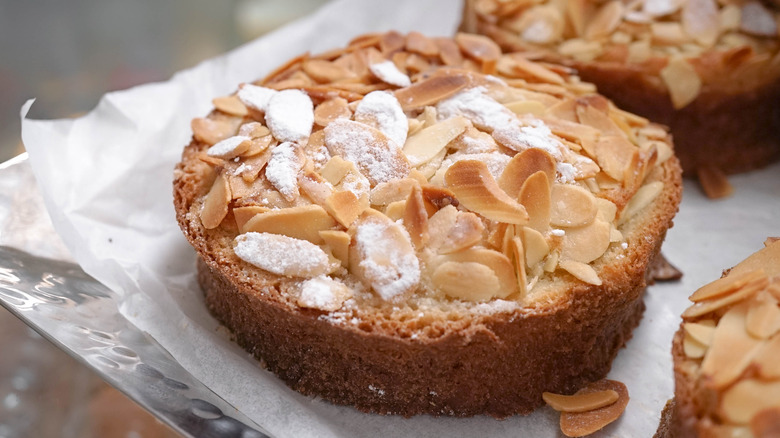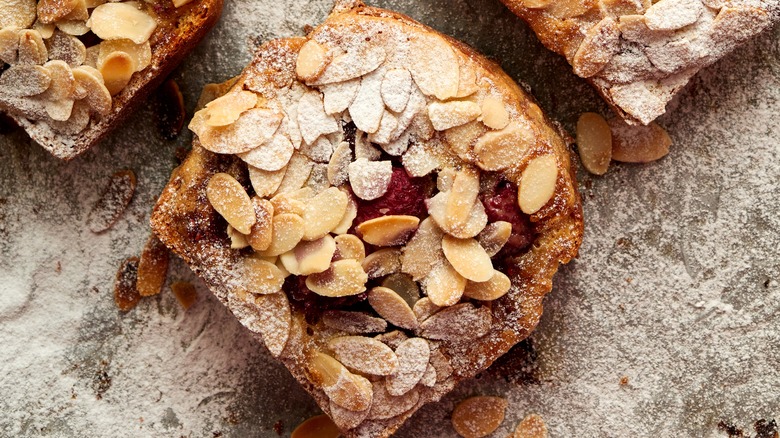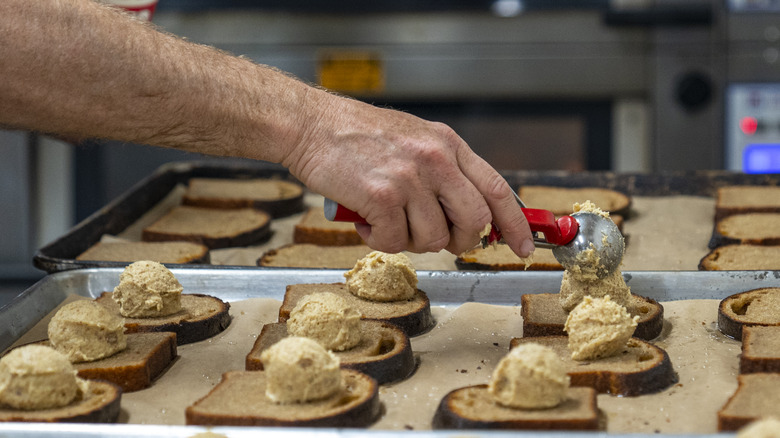France's Bostock Is The Perfect Way To Use Up Old Pastries Or Bread
Use your imagination for a moment. Let's say you've gone to visit your local bakery. A wonderful scent greets your nostrils as you enter through the front door. Subtle hints of sweet citrus and butter tell you that something rich has been baked today. Lo and behold, you are staring at steaming loaves of freshly baked brioche and challah. In your excitement, you buy one loaf too many, secretly knowing that while you'll certainly enjoy one, the other is likely to go stale. However, you have a trick up your sleeve because you know how to make bostock.
For a country that has produced such wonderfully complex-sounding desserts such as pâte à choux, tart tatin, crème brûlée, and kouign-amann, per Food52, bostock sounds exceptionally plain. We assure you, it is not. Bostock is France's clever way of utilizing leftover pastries or bread by taking full advantage of their staleness. As Claire Saffitz notes, stale bread is better at absorbing whatever syrup or seasoning you put on it, per YouTube. The closest thing you could compare bostock to would be French toast, but bostock is much more than your simple bread dipped in custard. It is a richly flavored wonder that transforms bread otherwise destined for food waste into delightful French goodness.
A bit of French ingenuity
There is no conclusive answer as to where in France bostock originated, and the prevailing theory is that it first came from somewhere in Normandy. As David Lebovitz points out, there is no definitive proof to back this claim other than bostocks popularity within the region. Bostock began appearing in shop windows sometime during the 1930s. Likely the product of bakers looking to use unpurchased bread, the fact that this pastry only has a recorded history dating roughly 90 years is probably why it remains relatively unknown, via The Feed by Zingerman's.
Regardless of where it came from, bostock is decidedly French. Puratos describes it as a bridge between French toast and an almond croissant. The leftover bread is soaked with sweets and coated in an almond-flavored topping. We'll get into the specifics of the traditional ingredients in a little while. The pastry is baked and emerges from the oven as a crisp, warm, tart-like delicacy. Despite its relative obscurity elsewhere, bostock remains an ever-popular snack in France. However, there are several stores, like Zingerman's, where you could purchase one. You could also easily make bostock at home and use it as a decadent breakfast or sumptuous dessert for an upcoming date or holiday.
Bring on the almonds
Although bostock is primarily a method of putting day-old bread to good use, a special ingredient elevates bostock above its simple station: frangipane. A gluten-free almond custard that can serve as the base for desserts such as Bakewell tart, frangipane is made by mixing almond paste or meal, flour, butter, sugar, eggs, and vanilla or almond extract until it forms a thick paste. The result is a sweet almond bomb that mustn't be confused with marzipan, which is more of a sweet, concentrated fondant, via MasterClass.
Of course, the most crucial ingredient in bostock is the bread itself. While traditionally made with brioche, there are several other alternatives one can use for the same effect. Any firm-textured bread, such as challah or pain de mie, and even a stout English muffin will serve well as the base for this sweet treat (per David Lebovitz and The Table by Harry and David). Other ingredients required for bostock include simple syrup, which is equal parts sugar and water, and some kind of jam. The jam can be any fruit preserve, but a favorite in France is the tangy, orange marmalade that amps up the citrus of this rich pastry, per Puratos.
Assembly and baking
Once you've gathered all of your ingredients, the assembly can begin. A quick note on the frangipane: You could easily make this on your own, and it's a simple matter of combining the aforementioned ingredients into a paste. As Masterclass states, swap out almond paste for an almond meal or flour if you're looking for a creamier frangipane. The creamy texture provided by the flour not only brings an added lightness but will also give a more rustic, homemade feel to your bostock than the more manufactured almond paste. Once the frangipane is made, you can dip or brush the stale bread slices with the simple syrup before smearing on a thin layer of jam. Next, coat the bread with a generous helping of frangipane, top with almond flakes — or fresh fruit as Claire Saffitz does on YouTube — and pop the assembly into a preheated oven. Your resulting bostock should come out with a crispy exterior and a warm, soft interior.
As The Feed by Zingerman's notes, the center of your bostock should be the most flavorful part, having absorbed all that wonderful syrup and jam. There are numerous ways to interpret bostock, and you can stick with the classic French ingredients or get more creative with flavor combinations of your own. Either way, this French delicacy will most certainly put a smile on your face.



